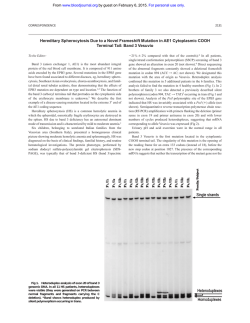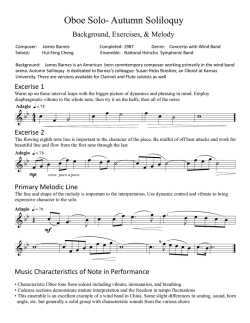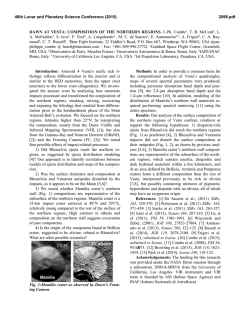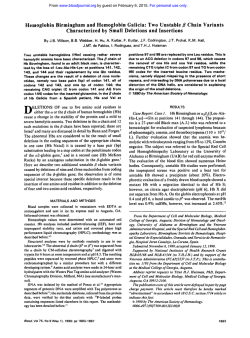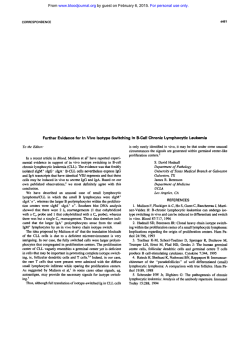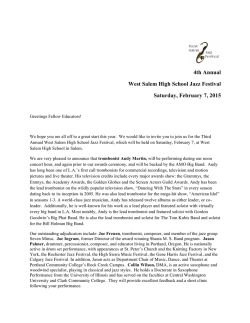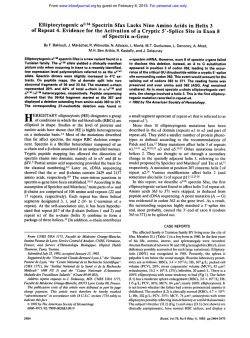
Southeast Asian Ovalocytosis in a South African Kindred
From www.bloodjournal.org by guest on February 6, 2015. For personal use only. CORRESPONDENCE 1656 Southeast Asian Ovalocytosis in a South African Kindred With Hemolytic Anemia To the Editor: Southeast Asian ovalocytosis (SAO) isa dominantly inherited disorder that is widespread in certain ethnic groups of Malaysia, Indonesia, Papua New Guinea, and the Philippines.’,2 SA0 red blood cells (RBCs) areovalocyticinshape,rigid,andresistanttoinvasion by different strains of malaria parasites.’l’ MembranesSA0 of RBCs do not undergo salt-induced crenation,’ and several blood group antigens, but not the Affected hetemGerbich antigens, havea reduced level of expression? zygous individuals are asymptomatic, with no clinically detectable hemolysis,’ although one subject has been described with compensated hemolysis.’ The homozygous state has been postulated to be lethal? The underlying moleculardefect in SA0 is a deletion of 27 bp in the band 3 gene resulting in the absence of 9 amino acids at the boundary of the cytoplasmic and membrane domains of band 3.9”’ This defect is tightly linked in all casesof SA0 to the band 3 Memphis I polymorglu substitution?The phism, a pointmutationcausing a lys56 prevalence of SA0 in other population groups is not known, but one Mauritian subjectof Indian extraction and oneAfrican-American family have been repo~ted.’,’’ We now describe the first instance of dominantly inherited SA0 in a four-generation South African Cape Colored familythatalso showed two additional unusual features. Firstly, all affected subjects exhibited varying degrees of hemolytic anemia. Secondly, the band 3 Memphis I polymorphism was not linked to SA0 the band 3 deletion in all subjects.The family members studied consisted of seven affected and three normal individuals. Clinically, all affected subjects showed evidence of hemolysis, ranging from a severe transfusion-dependant conditiontocompensatedhemolysis. One individualcontinuedto hemolyse after splenectomy.Other causes of hemolysis, such as hemoglobinopathies or enzyme deficiencies,wereruled out. RBCs from affected individuals showed the characteristic spoon-shaped stomatocytic ovalocytic morphology and incubation of SA0 RBC ghosts in isotonic saline did not alter themorphology,incontrasttocontrol ghosts that becamesmaller and echinocytic. In vitro infection ofSA0 and normal RBCs withPlasmodium falciparum and culturing for two cycles of parasite invasion and growth showed a markedly decreased level of parasitemia in SA0 cells. Several blood group antigens, including the Gerbich antigens, were depressed. Polymerase chain reaction (PCR) amplification of genomic DNA using primers flanking the S A 0 deletion in exon 11 of the band 3 gene showed two products of 175 and 148 bp, indicating that the affected individuals were heterozygous for the 27-bp S A 0 band 3 gene deletion. Normal family members only showed amplification of the 175-bp fragment. The presence of theband 3 Memphis I polymorphism was analyzed by limited tryptic digestion of RBC ghosts followed by electrophoresis and immunoblotting with an antiband 3 antibody. The protein findings were confirmed by PCR amplification of the band 3 gene and DNA sequencing. Interestingly, six S A 0 subjects and all three normal family members were heterozygous for the band 3 Memphis I polymorphism (Lys 56 Glu) and one S A 0 subject was homozygous. The Cape Coloreds are a hybrid people into whose ancestry a Caucasoid element has entered. The other element is usually of African origin (Khoi, San, or Negro), butmay also be the hybrid Caucasoids from Malaysia or India.I3The origin of this Cape Colored family is not known, but we speculate that the SA0 gene was introduced into the family ancestors during the 17th or 18th century by a Malaysian or Indonesian forebear who came to the Cape Town settlement with the Dutch East India Company. Alternatively, the SA0 gene deletion could have arisen independently in this family. This may be less likely because it is a relatively large deletion (27 + + bp) and, in addition, the Cape region of South Africa is notan endemic malaria area. It has been postulated that the S A 0 mutation is an ancient one probably selected for by the protection the gene affords against malaria.2,3 In summary, our results indicate that the S A 0 phenotype also occurs in the South African Cape Colored population and is not always clinically asymptomatic. Furthermore, the inheritance of the band 3 Memphis I polymorphism in an affected family is not necessarily indicative of SAO. T.L Coetzer L. Beeton D. van Zyl S.P. Field Department of Haematology School of Pathology University of the Witwatersrand South African Institute for Medical Research Johannesburg, South Africa A. Agherdien Port Elizabeth, South Africa E. Smart Natal Blood Transfusion Service Durban, South Africa G.L. Daniels MRC Blood Group Unit University College London London, UK REFERENCES 1. Amato D, Booth PB: Hereditary ovalocytosis in Melanesians. PNG Med J 20:26, 1977 2. Nurse GT, Coetzer TL, Palek J: The elliptocytoses, ovalocytosis and related disorders. Clin Haematol 5:187, 1992 3. Serjeantson S, Bryson K, Amato D, Babona D: Malaria and hereditary ovalocytosis. Hum Genet 137:161, 1977 4. Kidson C, Lamont G, Saul A, Nurse GT: Ovalocytic erythrocytes from Melanesians are resistant to invasion by malaria parasites in culture. Roc Natl Acad Sci USA 785829, 1981 5. Liu S-C, Zhai S, Palek J, Golan DE, Amato D, Hassan K, Nurse GT, Babona D, Coetzer T, Jarolim P, Zaik M, Borwein S: Molecular defect of the band 3 protein in Southeast Asian Ovalocytosis. N Engl J Med 323:1530, 1990 6. Booth PB, Serjeantson S , Woodfield DG, Amato D: Selective depresson of blood groups antigens associated with hereditary ovalocytosis among Melanesians. Vox Sang 32:99, 1977 7. Reardon DM, Seymour CA, Cox TM, Pinder JC, Schofield AE, Tanner MJA: Hereditary ovalocytosis with compensated haemolysis. Br J Haematol 85:197, 1993 8. Liu S-C, Jarolim P, Rubin HL, Palek J: The homozygous state for the band 3 protein mutation in Southeast Asian ovalocytosis may be lethal. Blood 84:3590, 1994 9. Jarolim P, Palek J, Amato D, Hassan K, Sapak P, Nurse GT, Rubin HL, Zhai S, Sahr KE, Liu S-C: Deletion in erythrocyte band 3 gene in malaria-resistant Southeast Asian ovalocytosis. Proc Natl Acad Sci USA 88:11022, 1991 10. Tanner MJA, Bruce L, Martin PG, Rearden DM, Jones GL: Melanesian hereditary ovalocytes have a deletion in red cell band 3. Blood 78:2785, 1991 11. Mohandas N, Winardi R, Knowles D, Leung A, Parra M, George E, Conboy J, Chasis J: Molecular basis for membrane rigidity of hereditary ovalocytosis. J Clin Invest 89:686, 1992 From www.bloodjournal.org by guest on February 6, 2015. For personal use only. CORRESPONDENCE 12. Ravindranath Y, Goyette G, Johnson RM: Southeast Asian ovalocytosis in an African-American family. Blood 84:2821, 1995 1657 13. Nurse GT, Weiner JS, Jenkins T: The growth of hybrid communities, in The Peoples of Southern Africa and Their Affinities. Oxford, UK, Oxford Clarendon, 1985, p 218 From www.bloodjournal.org by guest on February 6, 2015. For personal use only. 1996 87: 1656-1657 Southeast Asian ovalocytosis in a South African kindred with hemolytic anemia [letter] TL Coetzer, L Beeton, D van Zyl, SP Field, A Agherdien, E Smart and GL Daniels Updated information and services can be found at: http://www.bloodjournal.org/content/87/4/1656.citation.full.html Articles on similar topics can be found in the following Blood collections Information about reproducing this article in parts or in its entirety may be found online at: http://www.bloodjournal.org/site/misc/rights.xhtml#repub_requests Information about ordering reprints may be found online at: http://www.bloodjournal.org/site/misc/rights.xhtml#reprints Information about subscriptions and ASH membership may be found online at: http://www.bloodjournal.org/site/subscriptions/index.xhtml Blood (print ISSN 0006-4971, online ISSN 1528-0020), is published weekly by the American Society of Hematology, 2021 L St, NW, Suite 900, Washington DC 20036. Copyright 2011 by The American Society of Hematology; all rights reserved.
© Copyright 2026


